-
Welcome back Guest! Did you know you can mentor other members here at H-M? If not, please check out our Relaunch of Hobby Machinist Mentoring Program!
You are using an out of date browser. It may not display this or other websites correctly.
You should upgrade or use an alternative browser.
You should upgrade or use an alternative browser.
My tool room
- Thread starter jhuston
- Start date
- Joined
- Oct 15, 2016
- Messages
- 106
Thank you, it's a combination of factors:Impressive!!
-I'm known as the Porter-Cable guy in some circles, so people are forever contacting me with leads on machines
-I prefer the basketcases to the pristine examples, so it's a lot less expensive to buy them
-I'm in the MidWest ( Ohio), where all the industry was, and machines are easy to come by
-I genuinely have no other hobbies
The woodworking area is next door ( our shotgun bungalow has the basement divided by a cinder block wall, making it relatively easy to keep dust off the toolroom machines and grit away from the woodworking equipment). The first machines you see if you walk into that room are the band saws,
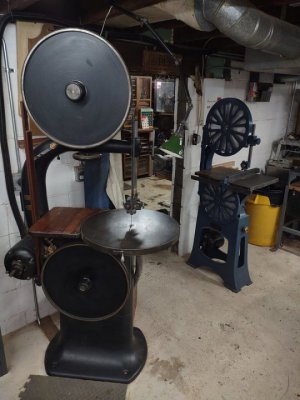
The one on the left is a Syracuse Sander BS 20" band saw, made around 1919 before the company was purchased by ( you guessed it) Porter-Cable in 1922. It's the only known example, and a truly wonderful machine to use. The smaller machine is a 16" Hutchinson Speed Marvel band saw, made around 1925. Hutchinson was allied ( noone's sure f they were purchased, or merely became partners ) with Porter-Cable in the late '20s and early '30s.
There's also the Hutchinson Beaver combination woodworker,
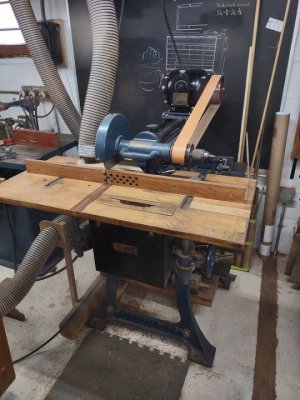
a clever machine that can function as a radial arm saw, rip saw, jointer, or horizontal borer. I use it as a RAS more often than not, so it lives right next to the wood rack, as it's the first machine a board encounters on it's way to be made into something.
Right beside the Beaver is the Hutchinson Handy Hutch,
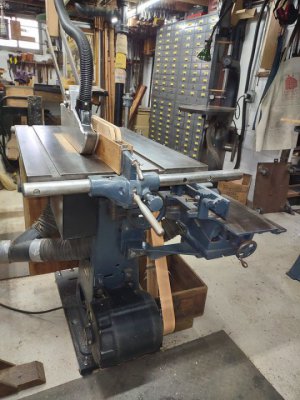
A 12" tilting table saw with an onboard 6" jointer. I've modified this machine quite a bit, from adding dust collection and a counterweight, ceiling-mounted guard to the Delta micro-set fence and rails and three-knife jointer cutterhead.
Then there's the Hutchinson Speed Marvel shaper,
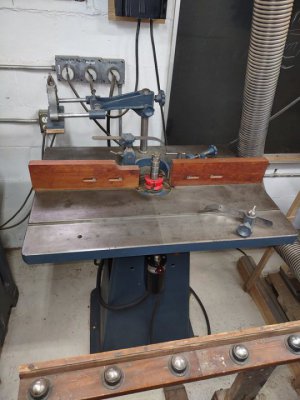
a 2hp, 1" spindle monster. Next to the shaper is my gang drill,
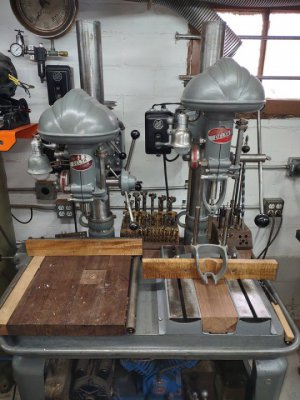
a frankensteined machine made from a 1939 drill press head ( left), a 1946 drill press head( right, set up for mortising), and a 1949 gang drill base.
Then we hit the air compressor.
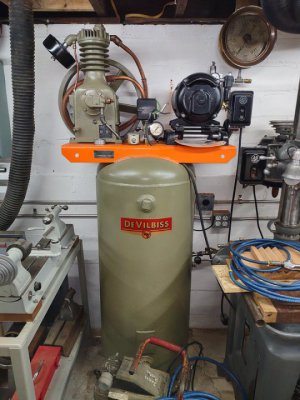
This is a 1945 Devilbiss that I'm almost finished restoring. I hydro-tested the tank, rebuilt the 130 pump, turned the armature in the repulsion start motor, and repainted it.
I have two wood lathes,
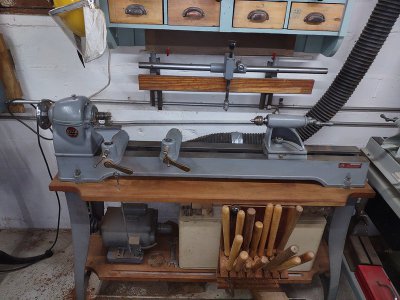
The main one being this 1947 Delta 1460 12". I also have a 1930s Delta 9" that I'm turning into a mini lathe with a variable speed D.C. motor.
Then there's all the sanders.
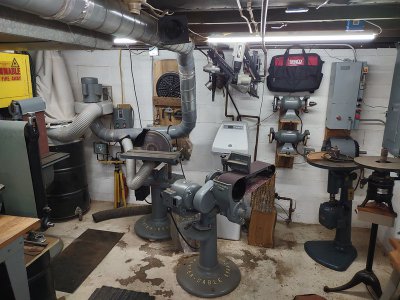
Left to right: a 1923-24 B-1 sander ( black) that's the only known example, and a complete heap that is going to take me years to rebuild, a late '40s B-3 10"x54" belt sander, a 1925-ish D-1 15" disc sander, a 1940s B-9 6"-54" belt sander, twin 116 6" bench grinders set up for lathe chisel sharpening/buffing, The c.1922 S-1 oscillating spindle sander, and lastly, my late'20s O-3 benchtop OSS.
I have another radial arm saw,
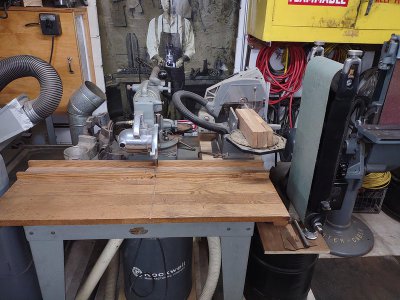
a 1950 Porter-Cable ERA radial arm attachment. With the right bracket in place, this machine can use any Porter-Cable saw of its day from 6" to 12", and also mount a router. Perched on the back is my Rockwell 9" miter saw, and to the left is my Delta 18" wedgebed planer.
Then there's my UBS shaper table,
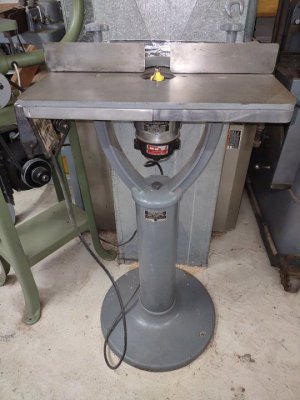
It was built around 1948, and was the first of many Porter-Cable router tables.
I have my smaller ( 1/2" spindle) shaper, and my 14" jigsaw,
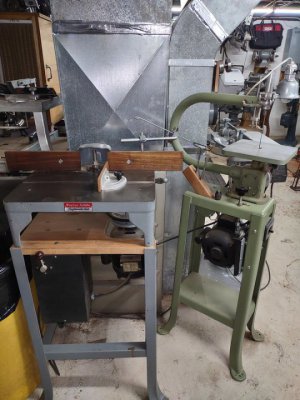
Both made for Porter-Cable by Henry Tools of London, Ontario, and only sold in Canada. The jigsaw has been retrofitted with a chopped and channeled Delta jigsaw stand, variable speed reeves drive and air blower, making it the most needlessly upgraded run-of-the-mill jigsaw you're ever likely to see.
This, however, is what it's all about,
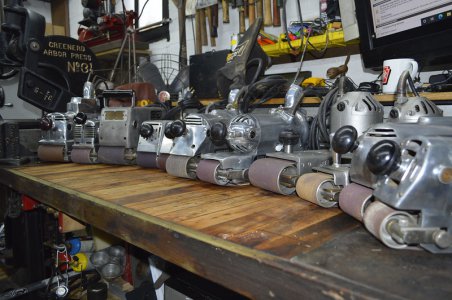
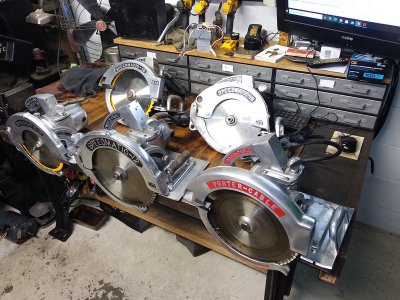
I have a toolcrib that houses something North of 140 power tools, all made by Porter-Cable between the years of 1926 and 1963, when the Rockwell name took over ( Rockwell purchased Porter-Cable in 1960, but kept the name around for a little while) . I have nothing against Rockwell tools in general, and there are some models that I've stored over a hundred examples of, but I prefer the earlier tools for their quality, looks, and performance. I restore handheld and stationary Porter-Cable machines for people from all over the United States, and hope to do so for many,many more years.
-James Huston
- Joined
- Oct 15, 2016
- Messages
- 106
Thanks, folks! History is a big part of the equation for me; there are several machines that served in WW2, including two USN stationary belt sanders and a deck crawler (one of the first thousand made to meet a USN contract), an Air Force circular saw and an Army Air Corps handheld belt sander that's powered by a miniature three-phase motor ( making it the earliest known example of a brushless power tool!). There are machines from a number of local businesses, now defunct ( or worse yet, overseas), and several machines that are the only survivor of their kind that anyone's ever seen, like my D-5 lapping machine or the B-1 sander.
I've worked as a power tool mechanic for the past twenty-two years; when I started, we would still get the occasional retired tradesman, stooped from a lifetime of labor, who would bring in a saw or sander for service that had been in their hand for fifty years- I used to stock the switch for a K-75 circular saw just for those guys, and in those days, Porter-Cable still carried them. I had customers leave the service after the war and go into homebuilding, wanting a cord for the tool they bought new in '46 ( and some of those tools found their way to me after the owners could no longer use them). It was nothing for a contractor to have the same circular saw for his entire career. I fabricated parts, reconditioned things that were too difficult to reproduce, turned armatures... it was a different world.
Towards the end, I was cracking open seventy-dollar grinders to see if I could get away with just a new cord since new brushes would put it over the customers' budget. I mean, who fixes things anymore? I tell you, the last two or three years of shoveling foreign-made dreck into a scrap barrel put such a bad taste in my mouth that I would often come home, walk down into the shop, and just sit amongst the dinosaurs of American engineering until my blood pressure went back to normal. There are few things more zen than a hundred-odd-year-old metal lathe, I think.
-James Huston
I've worked as a power tool mechanic for the past twenty-two years; when I started, we would still get the occasional retired tradesman, stooped from a lifetime of labor, who would bring in a saw or sander for service that had been in their hand for fifty years- I used to stock the switch for a K-75 circular saw just for those guys, and in those days, Porter-Cable still carried them. I had customers leave the service after the war and go into homebuilding, wanting a cord for the tool they bought new in '46 ( and some of those tools found their way to me after the owners could no longer use them). It was nothing for a contractor to have the same circular saw for his entire career. I fabricated parts, reconditioned things that were too difficult to reproduce, turned armatures... it was a different world.
Towards the end, I was cracking open seventy-dollar grinders to see if I could get away with just a new cord since new brushes would put it over the customers' budget. I mean, who fixes things anymore? I tell you, the last two or three years of shoveling foreign-made dreck into a scrap barrel put such a bad taste in my mouth that I would often come home, walk down into the shop, and just sit amongst the dinosaurs of American engineering until my blood pressure went back to normal. There are few things more zen than a hundred-odd-year-old metal lathe, I think.
-James Huston
- Joined
- Jan 28, 2022
- Messages
- 829
Great shop. I absolutely love the lathe, It's a work of art. I have the same Porter Cable 4x54"belt sander.
Last edited:
- Joined
- Oct 15, 2016
- Messages
- 106
Thank you! The Mulliner-Enlund is by far my favorite machine to run. In fact, I just finished up making a drawbar for my set of collets,Great shop. I absolutely love the lathe, It's a work of art. I have the same Porta Cable 4x54"belt sander.
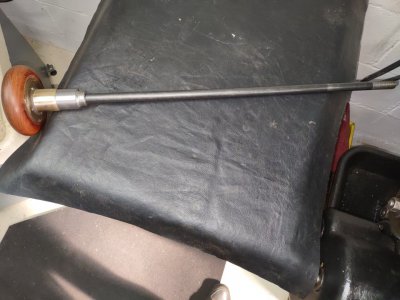
As for the sander, I confess I have. Weakness for them, both stationary and handheld ( love a worm drive sander).
- James Huston
- Joined
- Jan 28, 2022
- Messages
- 829
Nice work, looks great.Thank you! The Mulliner-Enlund is by far my favorite machine to run. In fact, I just finished up making a drawbar for my set of collets,
View attachment 405179
As for the sander, I confess I have. Weakness for them, both stationary and handheld ( love a worm drive sander).
- James Huston

